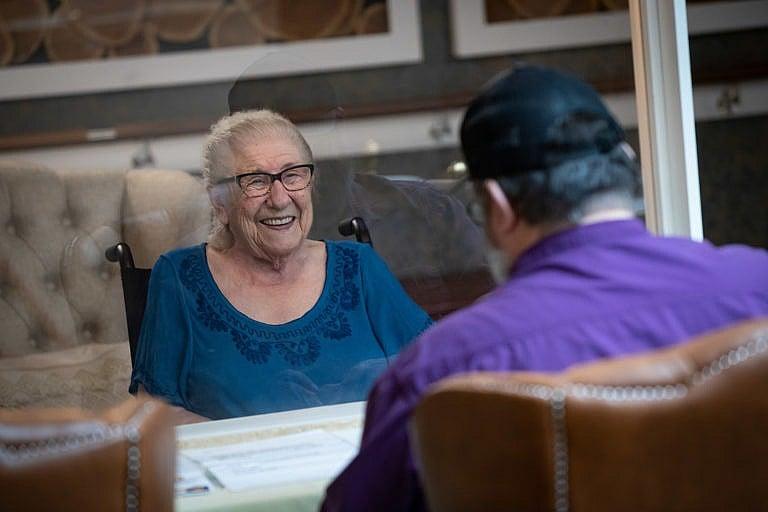Seniors deserve a life worth living during the COVID-19 pandemic
Our editorial: While physical isolation is key to the current approach to fighting COVID-19, it is also a significant causal factor in mental and physical problems among the elderly

Ivy Metz, 86, smiles at her son Nick Metz as they visit separated by a plexiglass barrier at Lynn Valley Care Centre, in North Vancouver, on July 17, 2020. (Darryl Dyck/CP)
Share
“Feeling that he might as well be dead”—and concerned that his nursing home administrator might find his secret stash of vodka—centenarian Allan Karlsson quietly slips out of his ground-floor room in Jonas Jonasson’s popular novel The 100-Year-Old Man Who Climbed Out the Window and Disappeared. Having gained his liberty, Karlsson enjoys a series of lively adventures involving gangsters, an elephant and an ample supply of dynamite. Setting aside the picaresque storyline, many Canadian seniors are feeling a lot like Karlsson these days.
For much of this year, residents of long-term care centres have suffered through COVID-19 lockdowns that ended social activities, stopped treasured visits from loved ones and forced isolated meals. With their freedom restricted, seniors who can do so are choosing to flee to make the most of the time they have left.
“We are seeing a real trend of people leaving retirement homes because they don’t want to be under those heavy restrictions,” Laura Tamblyn Watts, CEO of the seniors advocacy group CanAge, tells Christina Frangou in an insightful feature. While physical exclusion and loneliness are hallmarks of our current approach to fighting COVID-19, they are also significant causal factors in mental and physical problems among the elderly.
RELATED: Strict COVID-19 protocols are leaving seniors lonely, depressed and wondering: Is it worth it?
Senior care in Canada (which spends about 30 per cent less, as a percentage of GDP, on long-term care than comparable OECD countries) has long been marked by a depressing failure of focus. For decades, the entire topic was largely ignored and severely underfunded. So while the heart-wrenching outbreaks of COVID-19 in long-term care facilities have highlighted problems with existing preconditions there—from part-time staff working at multiple facilities to infection control—so, too, have they pointed to alternatives.
Dr. Sandy Buchman, past president of the Canadian Medical Association, told the CBC, “If you were a senior at home with the same vulnerabilities, you were 100 times less likely to die [of COVID-19] than you were if you were in a long-term care institution.” So let’s start by recognizing that over 90 per cent of all Canadian seniors do not live in retirement homes or long-term care centres but on their own, as a couple or with family. Yet only a tiny fraction of Canada’s total long-term care budget is spent on home care, where seniors’ personal autonomy is greatest. We should flip these figures. “Home care shouldn’t be something off to the side,” says Tamblyn Watts. “It is the cheapest, most effective and most desired form of seniors care.”
In line with Nordic countries, she recommends far greater provision of home care in order to keep seniors out of congregated care settings for as long as possible. Even palliative and end-of-life care services are best provided in a familiar residential environment, she says. “People want to be in their own homes at the end of their life. They don’t want to be in an institution.”
When—and if—institutionalized care becomes necessary, there are alternatives to warehousing in large buildings. The innovative Green House Project, for example, provides individual “houses” where small groups of 10 to 12 seniors can support and care for each other, with professional assistance as necessary. Facilities such as The Village in Langley, B.C., offer a welcome sense of familiarity and comfort to those suffering from dementia. And the appealing “campus of care” model, in which a continuum of care is offered at one location with residents flowing to different settings as their needs change, would likely be far more prevalent if it wasn’t for such a tangled regulatory burden.
However we care for Canada’s oldest citizens in the future—and it’s clear the status quo is decidedly deadly—we need to ensure that our recent focus on medical needs doesn’t rob seniors of everything else that makes life worth living. As much as we may enjoy the tale of Allan Karlsson’s prison break, a humane long-term care system should not make it a necessity.
This editorial appears in print in the November 2020 issue of Maclean’s magazine with the headline, “A life worth living.” Subscribe to the monthly print magazine here.